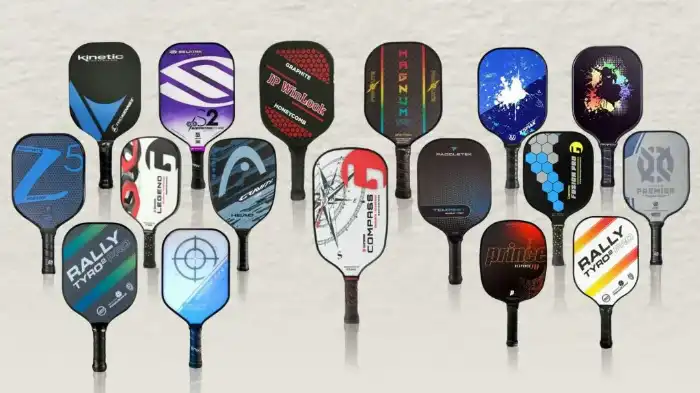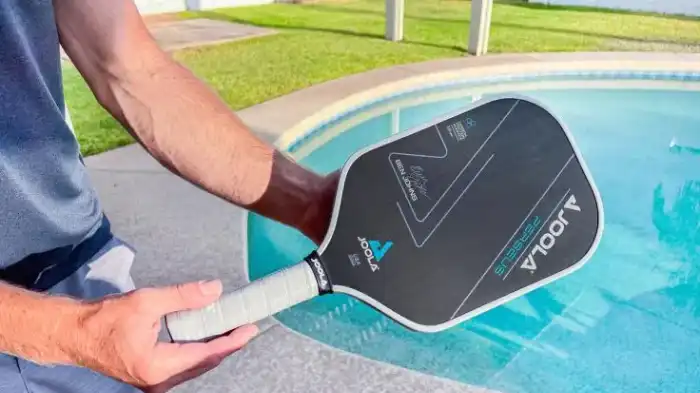Have you ever wondered how are pickleball paddles made? In this blog post, we will take a closer look at the manufacturing process of pickleball paddles. From the choice of materials to the final assembly, every step plays a vital role in ensuring the quality and performance of these paddles. So, let’s dive in and explore this fascinating world of pickleball paddle production!

Manufacturing Process of Pickleball Paddles
Let’s dive into the manufacturing process of pickleball paddles so that you will know how are pickleball paddles made:
Step 1: Choice of Materials
The first and one of the most important steps in making a pickleball paddle is selecting the right materials. Typically, pickleball paddles are made from composite materials, such as fiberglass, carbon fiber, or a combination of both. These materials provide excellent durability, strength, and lightweight properties that are essential for optimal gameplay on the court.
Once the materials are chosen, they undergo a rigorous quality check to ensure that they meet the predetermined specifications. This ensures consistency and guarantees that each paddle produced meets the same high standards.
Step 2: Foam Core Creation
Next, the foam core of the paddle is created. The foam core is responsible for providing the paddle’s structure and playability. The foam used in pickleball paddles is usually made of polymer or polypropylene materials. These materials offer a lightweight feel while maintaining the necessary rigidity to enhance ball control and power.
The foam core is shaped using molds, which can vary depending on the desired paddle specifications. These molds are carefully designed to create the desired shape and weight distribution for each paddle model. The foam is poured into the mold and left to set, ensuring a consistent and uniform core in each paddle.
Step 3: Adding the Face and Edge Guard
After the foam core is complete, the next step involves adding the paddle’s face and edge guard. The face is the hitting surface of the paddle and is usually made of a thermoplastic material such as graphite or fiberglass. These materials offer a smooth surface that allows for excellent ball control and shot precision.
An edge guard is then applied along the perimeter of the paddle to protect it from damage during gameplay. The edge guard is typically made from durable materials such as rubber or plastic. It acts as a buffer, absorbing the impact when the paddle accidentally hits the ground or any other hard surface, preventing any significant damage to the face or core.
Step 4: Finishing Touches and Assembly
Once the face and edge guard are in place, the paddle undergoes a final finishing process. This includes sanding the edges and applying a protective coating to enhance the paddle’s durability and aesthetics. The coating also helps to prevent scratches and extends the lifespan of the paddle.
After the finishing process, the handle and grip are attached to the paddle. The handle is typically made of materials like wood or composite, providing a comfortable and secure grip for the player. The grip is usually made of cushioned materials, such as synthetic or natural rubber, to ensure maximum control and minimize hand fatigue during play.
Step 5: Quality Control and Testing
After the paddles have been assembled, they undergo a rigorous quality control process. Each paddle is inspected for defects, such as bubbles or imperfections in the face material, loose edges, or inconsistencies in weight distribution. Paddles that pass the quality control tests are then tested for their performance characteristics in real-game scenarios.
Professional players and testers evaluate the paddle’s responsiveness, power, control, and durability. This ensures that the final product meets the expected standards and performs well in actual games.

Conclusion
In conclusion, delving into the intricate process of crafting pickleball paddles reveals a meticulous journey from material selection to final assembly. The careful choices of composite materials, the precise creation of the foam core, and the addition of the face and edge guard all contribute to the paddle’s quality and performance. The finishing touches, including sanding, coating, and grip attachment, complete the paddle-making journey.
A stringent quality control and testing phase ensures that each paddle meets the highest standards, providing players with a reliable and high-performing tool on the court. Understanding how are pickleball paddles made offers a newfound appreciation for the craftsmanship behind these essential pieces of equipment, enriching the player’s connection with the game.
FAQs: How Are Pickleball Paddles Made?
Pickleball paddles are typically made from materials such as graphite, composite, wood, or a combination of these. Graphite paddles offer greater power and control, while wood paddles are more budget-friendly and offer a unique feel. Composite paddles are a popular choice for their durability and versatility.
Yes, some manufacturers offer customizable options for pickleball paddles. This can include choosing specific materials, grip sizes, weight distributions, or even designing personalized graphics. Customization allows players to tailor the paddle to their playing style and preferences.
Paddle weights and sizes can vary to suit different player needs. Lighter paddles are usually preferred by players who seek maneuverability and control, while heavier paddles offer more power and stability. The paddle size, typically ranging from 6.5 to 8.0 inches wide and 15.5 to 17.0 inches long, affects the sweet spot and overall control. Players can choose a weight and size combination that best suits their playing style.
The manufacturing time for a pickleball paddle typically ranges from a few days to a couple of weeks. This timeline includes the selection of materials, creation of the foam core, addition of the face and edge guard, finishing touches, assembly, and rigorous quality control. The precise duration can vary based on the complexity of the design, specific materials used, and the efficiency of the production process.
Pickleball paddles are crafted through a meticulous process that begins with selecting durable materials like fiberglass and carbon fiber. The foam core, providing structure and playability, is shaped using molds. The face, usually made of materials like graphite or fiberglass, and the edge guard are added, followed by finishing touches and assembly of the handle and grip. The final product undergoes rigorous quality control, ensuring each paddle meets high standards for performance and durability.

